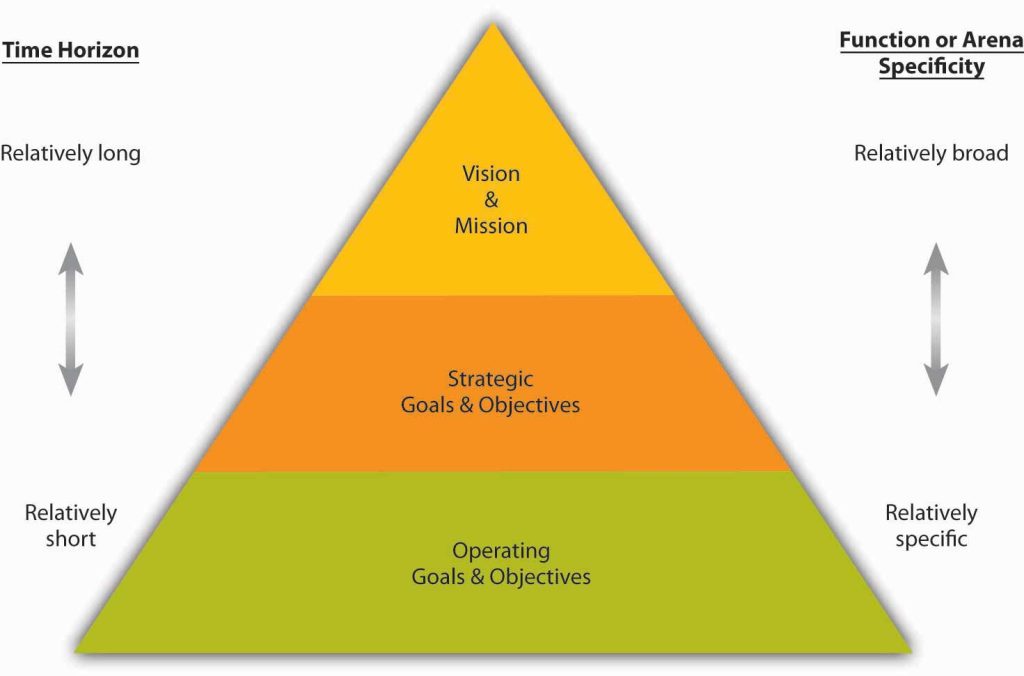9.5 The Nature of Goals and Objectives
Goals and objectives are a critical component of leadership; unfortunately, because their role and importance seem obvious, they also tend to be neglected in managerial practice or poorly aligned with the organization’s strategy. Often, they are just poorly communicated. You can imagine why this might be problematic, particularly since leader’s need to evaluate employee performance—it would be nice if employees could be evaluated based on how their achievement of individual goals and objectives contributes to those critical to the organization’s survival and success.
What Are Goals and Objectives?
Goals and objectives provide the foundation for measurement. While the terms are often used interchangeably, goals are outcome statements that define what an organization is trying to accomplish, both programmatically and organizationally. Goals are usually a collection of related programs, a reflection of major actions of the organization, and provide rallying points for leaders.
Example: Financial Goal – Growing Revenues
Walmart might state a financial goal of growing its revenues 20% per year or have a goal of growing the international parts of its empire. Try to think of each goal as a large umbrella with several spokes coming out from the centre. The umbrella itself is a goal.
In contrast to goals, objectives are very precise, time-based, measurable actions that support the completion of a goal – you have likely heard of SMART goals (which will be discussed further later in the chapter).

Umbrella Analogy
Objectives typically must:
- be related directly to the goal
- be clear, concise, and understandable
- be stated in terms of results
- begin with an action verb
- specify a date for accomplishment
- be measurable
Apply our umbrella analogy and think of each spoke as an objective. Going back to the Walmart example, and in support of the company’s 20% revenue growth goal, one objective might be to “open 20 new stores in the next six months.” Without specific objectives, the general goal could not be accomplished—just as an umbrella cannot be put up or down without the spokes. Importantly, goals and objectives become less useful when they are unrealistic or ignored. For instance, if your college has set goals and objectives related to class sizes but is unable to ever achieve them, then their effectiveness as a management tool is significantly decreased.
Measures are the actual metrics used to gauge performance on objectives. For instance, the objective of improved financial performance can be measured using a number metrics, ranging from improvement in total sales, profitability, efficiencies, or stock price. You have probably heard the saying, “what gets measured, gets done.” Measurement is critical to today’s organizations. It is a fundamental requirement and an integral part of strategic planning. Without measurement, you cannot tell where you have been, where you are now, or if you are heading in the direction you are intending to go. While such statements may sound obvious, the way that most organizations have set and managed goals and objectives has generally not kept up with this commonsense view.
Goals and Objectives
One of the major challenges is that goals and objectives are often not tied to strategy, and ultimately to vision and mission. Instead, you may often see a laundry list of goals and objectives that lack any larger organizing logic. Or the organization may have adopted boilerplate versions of non-financial measurement frameworks such as Kaplan and Norton’s Balanced Scorecard, Accenture’s Performance Prism, or Skandia’s Intellectual Capital Navigator (Ittner & Larcker, 2003).
Purpose of Goals and Objectives
Broadly speaking, goals and objectives serve to:
- Gauge and report performance
- Improve performance
- Align effort
- Manage accountabilities
Goals, Objectives, and Planning
Planning typically starts with a vision and a mission. Then leaders develop a strategy for realizing the vision and mission, and must communicate this well; their success and progress in achieving vision and mission will be indicated by how well the underlying goals and objectives are achieved. A vision statement usually describes some broad set of goals—what the organization aspires to look like in the future. Mission statements too have stated goals—what the organization aspires to be for its stakeholders. For instance, Mars, Inc., the global food giant, sets out five mission statement goals in the areas of quality, responsibility, mutuality, efficiency, and freedom. Thus, goals are typically set for the organization as a whole and set the stage for a hierarchy of increasingly specific and narrowly set goals and objectives.
Unless the organization consists of only a single person, there are typically many working parts that make up the whole. Functional departments like accounting and marketing will need to have goals and objectives that, if measured and tracked, help show if and how those areas are contributing to the organization’s goals and objectives. Goals and objectives can also be set for the way that departments interact. For instance, are the accounting and marketing areas interacting in a way that is productive?
Goals, Objectives, and Organizing, Leading, and Controlling
The way that the firm is organized can affect goals and objectives in a number of ways. For instance, a functional organizational structure, where departments are broken out by finance, marketing, operations, and so on, will likely want to track the performance of each department, but exactly what constitutes performance will probably vary from function to function.
In terms of leadership, it is usually top managers who set goals and objectives for the entire organization. Ideally, then, lower-level managers would set or have input into the goals and objectives relevant to their respective parts of the business. For example, a CEO might believe that the company can achieve a sales growth goal of 20% per year. With this organizational goal, the marketing manager can then set specific product sales goals, as well as pricing, volume, and other objectives, throughout the year that show how marketing is on track to deliver its part of organizational sales growth. Goal setting is thus a primary function of leadership, along with communicating the vision and holding others accountable for their respective goals and objectives that help achieve that vision.

Finally, goals and objectives can provide a form of control since they create a feedback opportunity regarding how well or how poorly the organization executes its strategy. Goals and objectives also are a basis for reward systems and can align interests and accountability within and across business units. For instance, in an organization with several divisions, you can imagine that leaders and employees may behave differently if their compensation and promotion are tied to overall company performance, the performance of their division, or some combination of the two.
“7.2 The Nature of Goals and Objectives” from Principles of Leadership & Management by Laura Radtke is licensed under a Creative Commons Attribution-NonCommercial-ShareAlike 4.0 International License, except where otherwise noted.

